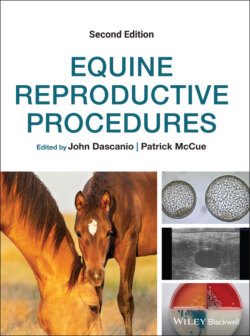Читать книгу Equine Reproductive Procedures - Группа авторов - Страница 32
Introduction
ОглавлениеInfectious endometritis is a significant cause of reproductive inefficiency in mares. Bacterial endometritis is most commonly caused by Streptococcus equi subspecies zooepidemicus, Escherichia coli, Pseudomonas aeruginosa, and Klebsiella pneumoniae, whereas the most common pathogens of uterine fungal infections are Candida species, Aspergillus species, and Mucor species. Diagnosis of bacterial or fungal endometritis is traditionally based on a combination of reproductive history, clinical signs, physical examination, and results of ultrasound, uterine culture, cytology, and biopsy evaluations.
Unfortunately, standard uterine culture techniques do not always detect bacterial or fungal organisms that are present in a mare with infectious endometritis. Problems include presence of slow growing or fastidious bacterial organisms and the difficulty in culturing anaerobic bacterial organisms. In addition, some fungal organisms are notoriously difficult to grow in culture.
Polymerase chain reaction (PCR) can be used to detect minute quantities of the nucleotide sequence of deoxyribonucleic acid (DNA). DNA contains highly conserved regions that have been maintained throughout phylogenic development (i.e., common throughout the taxonomic kingdom level) and variant regions, which can be used for the identification of genus and species.
Real‐time quantitative PCR (qPCR) assays work through primer probes specific for the conserved region of the 16S or 28S ribosomal DNA (rDNA) sequences for the detection of bacterial or fungal organisms, respectively. qPCR amplifies the target sequence of the rDNA, which is monitored in real time by measurement of increased fluorescence as the amplification process occurs. This allows for a semiquantitative analysis as a high level of fluorescence early in the replication process indicates a greater number of original DNA targets. The final result of the qPCR reaction is millions of copies of an amplicon (i.e., the 16S or 28S rDNA regions that the primers targeted). This initial step allows for the determination of whether bacterial or fungal DNA is present or absent.
A second step involves DNA sequencing of the amplicon, which determines the order of nucleotides (G, A, T, and C) in a segment of DNA. Determination of the nucleotide sequence allows for the identification of the genus and species of bacterial or fungal organisms, as each organism has a genetically different DNA sequence.
